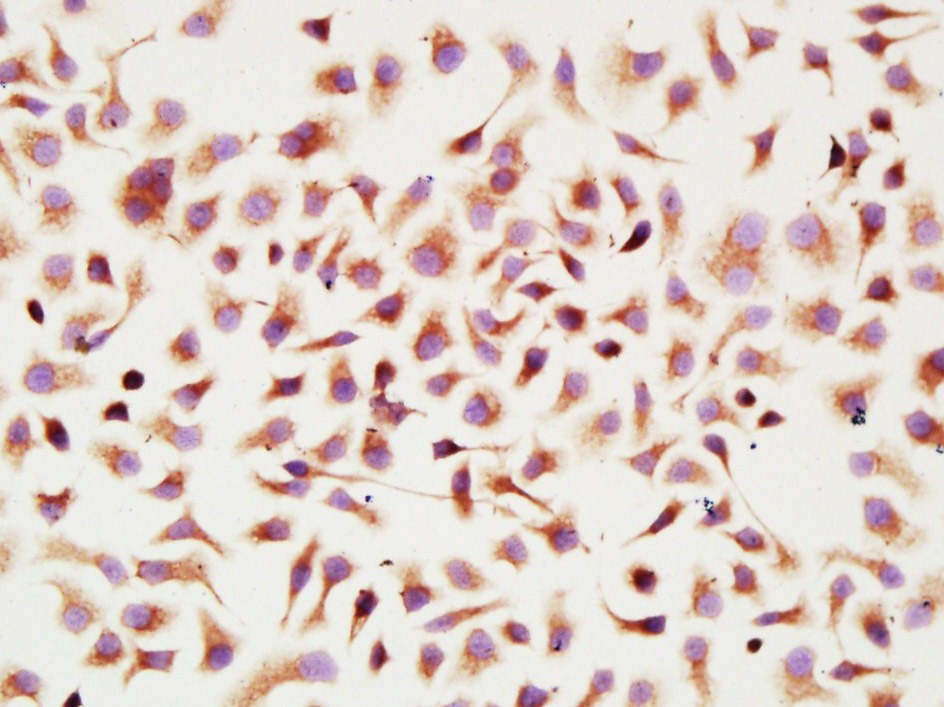Shopping Cart
Remove All Your shopping cart is currently empty
Your shopping cart is currently empty
Anti-Fibronectin Polyclonal Antibody 2 is a Rabbit antibody targeting Fibronectin. Anti-Fibronectin Polyclonal Antibody 2 can be used in ICC/IF,WB.
| Pack Size | Price | USA Warehouse | Global Warehouse | Quantity |
|---|---|---|---|---|
| 50 μL | $221 | 7-10 days | 7-10 days | |
| 100 μL | $372 | 7-10 days | 7-10 days | |
| 200 μL | $529 | 7-10 days | 7-10 days |
| Description | Anti-Fibronectin Polyclonal Antibody 2 is a Rabbit antibody targeting Fibronectin. Anti-Fibronectin Polyclonal Antibody 2 can be used in ICC/IF,WB. |
| Synonyms | FN1, Fibronectin |
| Ig Type | IgG |
| Reactivity | Human,Mouse,Rat (predicted:Chicken,Dog,Pig,Cow,Horse,Rabbit) |
| Verified Activity | 1. Sample: Lane 1: Kidney (Mouse) Lysate at 40 μg Lane 2: Cerebellum (Rat) Lysate at 40 μg Primary: Anti-Fibronectin/Ugl-Y3 (TMAB-00679) at 1/1000 dilution Secondary: IRDye800CW Goat Anti-Rabbit IgG at 1/20000 dilution Predicted band size: 263 kDa Observed band size: 263 kDa 2. Tissue/cell: HepG2 cell; 4% Paraformaldehyde-fixed; Triton X-100 at room temperature for 20 min; Block endogenous peroxidase by 3% hydrogen peroxide for 20 min; Blocking buffer (normal goat serum) at 37°C for 30 min; Antibody incubation with (Fibronectin/Ugl-Y3) Polyclonal Antibody, Unconjugated (TMAB-00679) at 1:400 overnight at 4°C, followed by operating according to SP Kit (Rabbit) instructionsand DAB staining.   |
| Application | |
| Recommended Dose | WB: 1:500-2000; ICC/IF: 1:100-500 |
| Antibody Type | Polyclonal |
| Host Species | Rabbit |
| Subcellular Localization | Secreted, extracellular space, extracellular matrix. |
| Tissue Specificity | Plasma FN (soluble dimeric form) is secreted by hepatocytes. Cellular FN (dimeric or cross-linked multimeric forms), made by fibroblasts, epithelial and other cell types, is deposited as fibrils in the extracellular matrix. Ugl-Y1, Ugl-Y2 and Ugl-Y3 are f |
| Construction | Polyclonal Antibody |
| Purification | Protein A purified |
| Appearance | Liquid |
| Formulation | 0.01M TBS (pH7.4) with 1% BSA, 0.02% Proclin300 and 50% Glycerol. |
| Concentration | 1 mg/mL |
| Research Background | This gene encodes fibronectin, a glycoprotein present in a soluble dimeric form in plasma, and in a dimeric or multimeric form at the cell surface and in extracellular matrix. Fibronectin is involved in cell adhesion and migration processes including embryogenesis, wound healing, blood coagulation, host defense, and metastasis. The gene has three regions subject to alternative splicing, with the potential to produce 20 different transcript variants. However, the full-length nature of some variants has not been determined. [provided by RefSeq, Jul 2008]. |
| Immunogen | KLH conjugated synthetic peptide: human Fibronectin/Ugl-Y3 |
| Antigen Species | Human |
| Gene Name | FN1 |
| Gene ID | |
| Protein Name | Fibronectin |
| Uniprot ID | |
| Biology Area | Extracellular matrix,Extracellular Matrix,Ectoderm,Fibronectin,Ectoderm,Osteogenesis,Extracellular |
| Function | Fibronectins bind cell surfaces and various compounds including collagen, fibrin, heparin, DNA, and actin. Fibronectins are involved in cell adhesion, cell motility, opsonization, wound healing, and maintenance of cell shape. Anastellin binds fibronectin and induces fibril formation. This fibronectin polymer, named superfibronectin, exhibits enhanced adhesive properties. Both anastellin and superfibronectin inhibit tumor growth, angiogenesis and metastasis. Anastellin activates p38 MAPK and inhibits lysophospholipid signaling. |
| Molecular Weight | Theoretical: 259 kDa. |
| Stability & Storage | Store at -20°C or -80°C for 12 months. Avoid repeated freeze-thaw cycles. |
| Transport | Shipping with blue ice. |
| Size | Quantity | Unit Price | Amount | Operation |
|---|

Copyright © 2015-2025 TargetMol Chemicals Inc. All Rights Reserved.